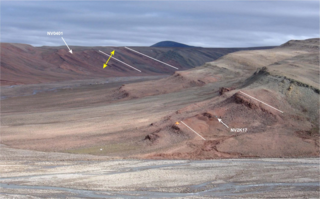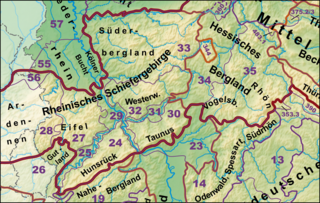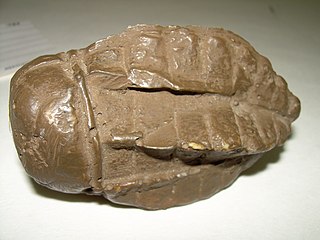
Limestone is a type of carbonate sedimentary rock which is the main source of the material lime. It is composed mostly of the minerals calcite and aragonite, which are different crystal forms of CaCO3. Limestone forms when these minerals precipitate out of water containing dissolved calcium. This can take place through both biological and nonbiological processes, though biological processes, such as the accumulation of corals and shells in the sea, have likely been more important for the last 540 million years. Limestone often contains fossils which provide scientists with information on ancient environments and on the evolution of life.

The Taunus is a mountain range in Hesse, Germany, located north west of Frankfurt and north of Wiesbaden. The tallest peak in the range is Großer Feldberg at 878 m; other notable peaks are Kleiner Feldberg and Altkönig.

Holoptychius is an extinct genus of porolepiform lobe-finned fish from the Middle Devonian to Carboniferous (Mississippian) periods. It is known from fossils worldwide. The genus was first described by Louis Agassiz in 1839.

The Fram Formation is an Upper Devonian (Frasnian) sequence of rock strata on Ellesmere Island that came into prominence in 2006 with the discovery in its rocks of examples of the transitional fossil, Tiktaalik, a sarcopterygian or lobe-finned fish showing many tetrapod characteristics. Fossils of Laccognathus embryi, a porolepiform lobe-finned fish, and Qikiqtania, a close relative of Tiktaalik, were also found in the formation. The Fram Formation is a Middle to Upper Devonian clastic wedge forming an extensive continental facies consisting of sediments derived from deposits laid down in braided stream systems that formed some 375 million years ago, at a time when the North American craton ("Laurentia") was straddling the equator.

The Rhenish Massif, Rhine Massif or Rhenish Uplands is a geologic massif in western Germany, eastern Belgium, Luxembourg and northeastern France. It is drained centrally, south to north by the river Rhine and a few of its tributaries.

Onychodus is a genus of prehistoric lobe-finned fish which lived during the Devonian period. It is one of the best known of the group of onychodontiform fishes. Scattered fossil bones of Onychodus were first discovered in 1857, in North America, and described by John Strong Newberry. Other species were found in Australia, England, Norway and Germany showing that it had a widespread range.

The Klerf Formation is an Early Devonian (Emsian) formation that includes a Lagerstätte in the Northern Eifel hills, at Willwerath near Prüm, Rhineland-Palatinate, Germany. In it Jaekelopterus rhenaniae, a giant eurypterid was discovered. The Klerf Formation, comprising greenish and reddish shales, siltstones and sandstones, was first described in 1919 by Rudolf Richter (1881-1957) and reaches a maximum thickness of about 1,300 metres (4,300 ft). It is part of Alken quarry along with Nellenköpfchen Formation.
The Kačák Event, also known as the Kačák-otomari Event, is a widely recognised bioevent or series of events that occurred close to the end of the Eifelian Age of the Middle Devonian Epoch. It involved a global eustatic rise in sea level and ecological turnover. It was named for the Kačák Member of the Srbsko Formation in Bohemia, where it is represented by a black shale interval within a sequence of limestone. In marine environments, this appears as an anoxic event, often forming potential hydrocarbon source rocks such as the Marcellus Shale. Within the Old Red Sandstone continent, it is represented by the Achanarras lake, the deepest and most widespread lake that developed within the Orcadian Basin. The event is associated with significant extinctions, particularly amongst the Ammonoidea.
The Leduc Formation is a stratigraphic unit of Late Devonian (Frasnian) age in the Western Canada Sedimentary Basin. It takes its name from the city of Leduc, and it was formally described from the B.A. Pyrz No. 1 well in central Alberta, between the depths of 1,623.7 m (5,327 ft) and 1,807.5 m (5,930 ft), by Imperial Oil Limited in 1950. Supplementary information came from a complete section of the formation that was cored in Imperial Oil's Leduc No. 530 well between 1,633 m (5,358 ft) and 1,863 m (6,112 ft).

Hexagonaria is a genus of colonial rugose coral. Fossils are found in rock formations dating to the Devonian period, about 350 million years ago. Specimens of Hexagonaria can be found in most of the rock formations of the Traverse Group in Michigan. Fossils of this genus form Petoskey stones, the state stone of Michigan. They can be seen and found in most Midwestern U.S. states.

Cupressocrinitidae is an extinct family of crinoid from the Middle to Late Devonian. Cupressocrinites is a representative of this family.

Paraspirifer is a genus of large brachiopods that lived during the late Lower and Middle Devonian in what now are Germany, Spain, Morocco and the United States.
The Traverse Group is a geologic group in Michigan, Indiana and Ohio comprising middle Devonian limestones with calcareous shale components. Its marine fossils notably include Michigan's state stone, the Petoskey stone, among other corals and records of ancient marine life. A range of trilobites has also been found in the Traverse Group.

The Cairn Formation is a geologic formation of Late Devonian (Frasnian) age in the Western Canada Sedimentary Basin. It was named for the Cairn River near its junction with the Southesk River in Jasper National Park by D.J. McLaren in 1955.
The Flume Formation is a geologic formation in the Western Canada Sedimentary Basin in Alberta, Canada. It was deposited as an extensive carbonate platform along the western edge of the basin during Late Devonian (Frasnian) time and the reefs of the Cairn Formation subsequently developed on it.
The Fairholme Group is a stratigraphic unit of Late Devonian (Frasnian) age. It is present on the western edge of the Western Canada Sedimentary Basin in the Rocky Mountains and foothills of Alberta and British Columbia. It was named for the Fairholme Range near Exshaw in the Canadian Rockies by H.H. Beach in 1943.
Douvillinella is an extinct genus of prehistoric brachiopods in the extinct family Douvillinidae. Species are from the Devonian of the Czech Republic and Germany. C. elegans is found only at Arauz Formation, Lezna Member, Palencia Province, North Spain.

The Prüm Syncline, Prüm Limestone Basin or Prüm Basin is a landscape unit of the southern Limestone Eifel in Germany, which in turn is part of the Eifel mountain range. The region lies in the German state of Rhineland-Palatinate. The Prüm Limestone Basin has an area of 240 km2 and is the largest of the Eifel limestone basins. Geologically it contains dolomite formed from the fringing reefs or barrier reefs of the Devonian on the edge of the Rheno-Hercynian Basin mixed with rocks of other earth-historical periods. It is named after the largest settlement in the region, the town of Prüm, and the River Prüm, whose right bank running from northeast to southwest marks the western boundary of the basin. In the east the basin extends beyond the village of Büdesheim almost to the Gerolstein Basin and the Hillesheim/Ahrdorf Basin, whose borders in the Upper Bettingen bunter sandstone region are unclear. In the southwest the basin runs from Schönecken with the exposed rock formations of the Schönecker, Switzerland in the direction of Daleiden. The region lies at an average height of 500 to 550 metres above sea level.

The Vireux-Molhain national nature reserve (RNN104) is a national nature reserve of geological and paleontological interest. It is located in the Pointe de Givet, department of Ardennes, on the border between France and Belgium. It covers an area of 1.82 ha. The site is known as Customs Wall as it is near an old customs post. This outcrop of Middle Devonian shale is notable for the quantity and good state of preservation of its fossils. Trilobites are well-represented.
Dudleyaspis is an extinct genus of Lower to Middle Devonian odontopleurid trilobites that lived in a shallow sea that lay between Euramerica and Gondwana. It was named in 1949 by Prantl & Pribyl.













